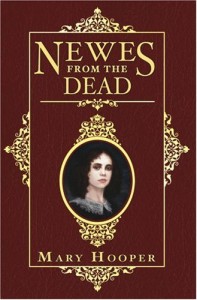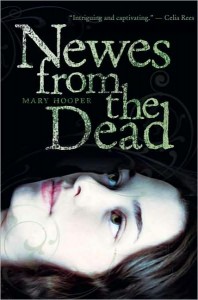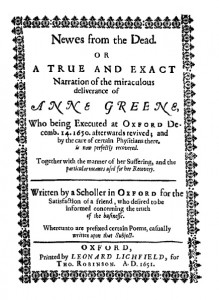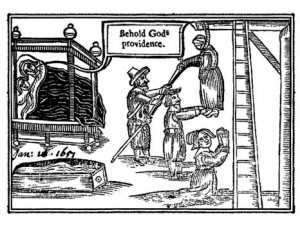Title: Newes From the Dead
Author: Mary Hooper
Genre: Historical Fiction, Young Adult
Publisher: Bodley Head Children’s (Random House UK) / Roaring Book Press (Macmillan US)
Publication Date: April 2008 (UK & US)
Hardcover: 320 pages
Stand alone or series: Stand alone novel.
Why did I read this book: Recently, looking back at all the titles both Ana and I have reviewed over the course of our Young Adult Appreciation Month, I was shocked to see that neither of us had read or reviewed a YA historical fiction (save for A Countess Below Stairs, reviewed earlier today). And, when I remembered that I had a review copy of Newes from the Dead on my TBR pile, I decided that it was time to give it a read. As YA Historical Fiction was one of my favorite genres as a kid (to this day, Mara: Daughter of the Nile remains one of my favorite books of all time – not to mention other classics like Ann Rinaldi’s The Last Silk Dress or Avi’s The True Confessions of Charlotte Doyle).
Summary: (from amazon.com)
It is 1650 and a baby lies raw and cold, dead before it even drew breath. A young servant girl, terrified and alone, is accused of its murder and sent to the gallows. Protesting her innocence in the chill air of a December morning, Anne Green is hanged. Moments later her lifeless body is lifted down from the scaffold and carried to the College of Physicians for brutal dissection.
But as Anne’s corpse lies on the table and the doctors assemble, a strange rattle is heard in her throat. Against all the odds, could she still be alive?
Review:
On a cold winter’s night in 1650, Anne Green awakens from a dark slumber, and she realizes that she cannot move. Slowly she remembers her last breath before her long sleep, with a hangman’s noose around her neck. Anne fears that she has died, and now lies in some horrible state of purgatory, buried beneath ground in a coffin, doomed to darkness and for all eternity. With nothing else to do, Anne begins to recount her sad story from the beginning; her first days housemaid in the home of a powerful family, the attentions and empty promises of the young lord of the house, and her ultimate demise as she’s found guilty of fornication and murder. Parallel to Anne’s recollections is another storyline, where a young noble with a pronounced stammer gathers around Anne’s body with his fellow students and doctors in Oxford, ready to dissect her still fresh body for the purposes of scientific inquiry. But then, the men see Anne’s eyelids twitch. Eager to make their reputations, the physicians of Oxford try to revive Miss Anne Green from her half-dead state – for against all logic, the girl has faced the gallows protesting her innocence and has survived.
Newes from the Dead takes its title and its subject matter from a pamphlet published in 1650 – the shockingly true tale of a young woman who was found guilty of infanticide, hanged, and pronounced dead only to show signs of life hours later on the dissection table and become revived by her would-be autopsists. Anne Green’s morbid but fascinating tale, as heard by Mary Hooper on the radio one day inspired her to weave a compelling novel around the historical account.
And compelling Ms. Hooper’s historical fiction is. In effect, the plot is already spelled out from the synopsis – there are no surprises or twists in Newes from the Dead, as we know from the beginning that this is a story about a young girl who miraculously survives her execution and a close brush with dissection. It is testament to Ms. Hooper’s writing that even though the overall plot is known well ahead of time, Newes from the Dead is a haunting, even thrilling read.
There are two parallel stories being told in Newes from the Dead – there’s Anne’s recounting in her immobile body, and there’s the tale of Sir Robert Matthews observing the looming dissection with feelings of apprehension. These storylines converge as Robert sees Anne’s eyelids twitch and stays by her side until she is fully revived. Anne’s memories of her time as a housemaid in the home of Sir Thomas is a tragic and completely believable tale. As a pretty young maid, Anne attracts the attention of Sir Geoffrey, grandson of Sir Thomas of the house – and Geoffrey is relentless in his pursuit of Anne, showering her with sweet words and empty promises of wealth, stature and a safe future as his wife. And Anne, young and naive girl that she is, gives in to his advances, though later she tries to flee his attention. Anne’s shame at believing Geoffrey, even though it was momentary, is painful to read and heartbreaking because it seems so plausible. When Anne finds herself pregnant and then shunned by Geoffrey completely, the pain intensifies. I couldn’t help but feel for the poor girl, caught in an impossible position. The engineering of her quick death sentence, at the hands of the influential Sir Thomas of course, only enhances the aura of dread and helplessness that young Anne feels – indeed, what any number of women or unprivileged persons must have felt in the early days of Cromwell. Anne’s tale is the heart of Newes from the Dead, as Ms. Hooper writes a heartbreakingly story about the events leading up to, and immediately following, her execution.
The other storyline, told with insight to young, stammering Robert’s perspective in the auditorium, is a different type of tale but equally compelling. Robert, prisoner in his own body as much as Anne is by his inability to speak around his colleagues, is an endearing hero counterpart to Anne’s sad story. While Anne lies in a fugue state, Robert remembers his own sad past and finds himself drawn to Anne’s story, and desperately hopes for her to live through her ordeal. If the events in Anne’s memory are a beautifully told story of heartache and abuse, Robert’s observations in Oxford with the physicians, a Puritan and the hateful Sir Thomas are the events that make Newes from the Dead a historical thriller of sorts. Even knowing that the dissection does not happen, I found myself holding my breath at the exclamations and angry arguments from Sir Thomas and the religious Puritan, and I eagerly hoped along with Robert that the physicians – with self-promoting motives of their own, remember – would be able to save young Anne Green’s life. For, even when they knew that Anne was not quite dead, urging her back to resuscitated life – especially with Sir Thomas so eager to make sure she stayed silent and dead – was no small feat.
If this were an Edgar Allen Poe story (which it does share the same sort of ominous foreboding), doubtless Anne Green would survive the gallows only to suffer some other morbid fate – dissected alive, or buried alive. But Ms. Hooper’s Newes from the Dead takes the heavy subject matter with all its gruesome possibilities and instead ends on a happy and completely fulfilling note. This is one well-written, strong novel, and I cannot wait to read more of Ms. Hooper’s historical fiction.
Notable Quotes/Parts: From the opening chapter:
It is very dark when I wake. This isn’t frightening in itself, because most of the year I rise in darkness, Sir Thomas insisting that as much of the house as possible be put in order before any of the family is about. It is the quality of the darkness that is strange; blacker than black, soft and close about me.
I go to turn my head toward the window, to see if any streaks of light can be seen in the sky, but my head doesn’t move! I try again, and again. I lift my hand—or try to—but it doesn’t want to obey me either.
It must be that I am deeply asleep, in some sort of trancelike state, and aware that I’m dreaming. I think I will just waitfor it to pass so I may rise, dress, and go about my household duties.
The waiting continues, and I feel nothing: neither cold nor warm, hungry nor replete. I just sense the blackness and soaring emptiness, but this is not too unpleasant. Some time later, though I cannot tell how long, I perceive movement across the backs of my eyes: four blurry white streaks, moving and gliding in the blackness. The streaks are feathery soft and remind me of doves, or of the soft, enveloping wings of angels. The blurry shapes dance across my eyelids, but when I try to stop them, to endeavor to focus on one and see if I can spy a shining halo or a gold harp, I find it impossible.
I would like it to be angels that I dream of, for I know that would be very lucky. The Reverend Coxeter told us that. He said that no matter whether you are a scullery wench or a lord in his castle, you are truly blessed if you dream of angels. I have tried to dream of them ever since I heard that, but have never succeeded.
Suddenly I remember something and want to scream with terror, and the blackness loses its velvety softness and takes on an aspect of such vast and unknown fears that the angels disappear. What I have remembered is this: the last time I saw the Reverend Coxeter ’twas not in church, but in a bleak yard in the icy rain, and he was entreating the Lord to have mercy on me, preserve my soul, and convey me quickly to paradise. Behind him had stood a great crowd of people, a man wearing a black hood, and a mighty wooden scaffold from which hung a heavy, knotted rope. And it was for me that all these were waiting, for I was . . . was about to be hanged.
A terrifying thought comes to me: If this happened, am I now dead? No, I cannot be, for surely I can hear my heart thumping within me and echoing through my ears. Then is this the state that they tell us about in the Bible? Is this purgatory?
I struggle to think, and recall that purgatory is said to be a painful state, with tortuous fires that cleanse the soul and bring it to righteousness. But how long does it last, this purgatory? A very long time, I think—thousands of years.
My state is not painful now, though, so perhaps it might not be too terrible to be in purgatory. If it just means lying here quietly in the dark, it might be quite bearable. There would be no rising at two in the morning on washing day to soak the linen, no more scrubbing of the kitchen range until my hands bleed, no more going without food for breaking a plate and being unable to sleep for hunger. No more of that, either—that which Geoffrey Reade sought. As I think on this, I feel a shadow pass over my soul and know, without being sure of the circumstances, that he is inexplicably connected to my fate.
I leave this thought atremble in the air and move on. Yes, I could, perhaps, bear purgatory. What I cannot bear . . . what I won’t contemplate is . . . no, no! I won’t let that thought in. But it comes anyway: What I could not bear, dare not consider, is the possibility that I’m not dead, but merely occupying a coffin, having been buried alive.
I’m of a sudden desperate to come out of the trance I must be in, for surely—oh, surely—I am still in the little bedroom I share with Susan, and only deeply asleep. I urge myself on. In my mind’s eye I picture myself pushing back my coarse blanket, swinging my legs out of the bed, and rising up, but though the urge is there, though I think I can perceive my muscles trembling with the effort to work, nothing happens and no part of me moves.
I concentrate harder. Maybe sitting up is asking too much of my body. It will be enough if I can move my hand, feel what’s around me: the straw mattress beneath me and the blanket on top. Once I know that I’m safe in my bed, I’ll be content to lie here longer.
I realize then that instead of being in my usual sleeping position, curled up like a wood louse, I’m lying straight and still with my hands crossed over my breasts. But this is not the usual manner in which I go to sleep . . .
My limbs are not working, but my mind is going ahead, whirling on a dance, showing me images of the effigy in St. Mary’s: a stone woman lying with her arms crossed over her cold stone body. Indeed! That’s how they lay out the dead! I’m so disturbed by this image that for a moment I forget to breathe.
I open my eyes; close them again. It makes no difference to the quality of the darkness. In fact I don’t know if I’m opening my eyes or just dreaming I am. Am I asleep or awake? Alive or dead? Am I already a cadaver?
My heart contracts with terror; there is a pain behind my eyes where I long to cry and a choking in my throat, but it seems that even crying is denied me. I begin to count to calm myself down. It is what I learned to do when Master Geoffrey was—but no, I cannot think on that yet.
I wonder if this state, this condition of mine, is punishment for what I have done, for they are very hard with all who commit sin now, and I have heard of women who have fornicated being tied on a ducking stool and dropped into a pond, and those who have stolen being whipped around the village behind a cart. I have never heard of anyone being buried alive, though.
I am very, very frightened. If I find out that I am buried, I’ll claw at the wood that surrounds me, scratch the walls of my coffin, and break out. But what will I do then? If I’m a buried corpse, then I’m under six feet of earth and will never get free. Best to die quickly perhaps, to clamp my lips together, stop myself from drawing breath, and perish.
In the blackness behind my eyes I try to see the blurry shapes again and turn them into comforting angels, but I cannot. Instead, chunks of my life come crowding in, clamoring to be heard, asking that they be considered in order to make sense of what’s happened to me.
Additional Thoughts: Anne Green was revived in 1650, and lived out a full life – in fact, becoming something of an icon, inspiring narrations in prose, poetry and even a woodcut, as pictured below.
But how did Anne Green survive her hanging (for thirty minutes, no less)? In the author’s afterward and after doing a cursory search online, the common theories involve a misplaced noose that failed to break Anne’s neck or even fully throttle her. Combined with the very cold weather which may have saved her from death by lack of oxygen, Anne managed to survive.
Verdict: Newes from the Dead is a strong novel in terms of characters and skillful plotting. I certainly recommend it for anyone looking for a grittier young adult historical novel, and look forward to reading more of Ms. Hooper’s work!
Rating: 6 – Good, recommended
Reading next: Libyrinth by Pearl North















2 Comments
Valentin Tredway
August 2, 2012 at 10:12 ambecause I need great one I wanted reviews or info on
My Favourite Books of 2013 | Memoranda
December 17, 2016 at 12:52 am[…] Two Boys Kissing by David Levithan. I was also impressed with Mary Hooper’s historical novel, Newes from the Dead (subtitled, Being a True Story of Anne Green, Hanged for Infanticide at Oxford Assizes in 1650, […]